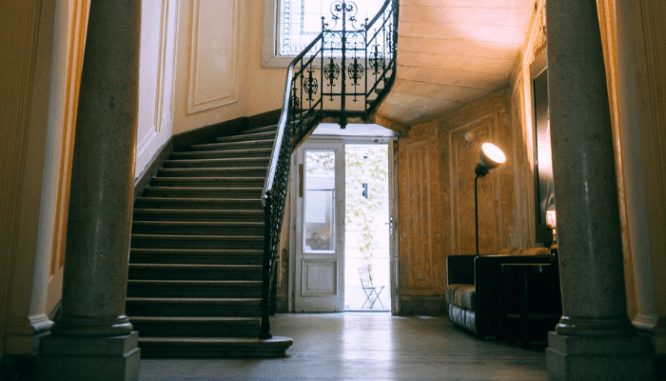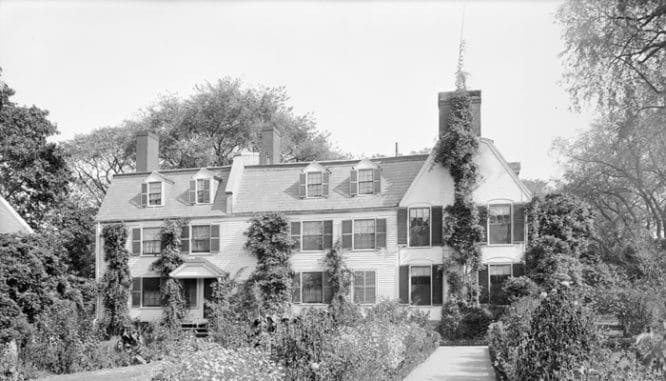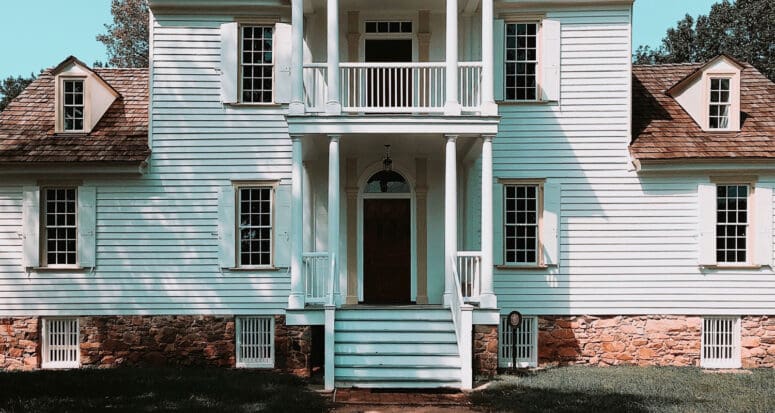Have You Seen ‘The Money Pit’? Ever Wondered How Much It’d Cost to Fix Today?
- Published on
- 5-6 min read
-
 Kim Upstill Contributing AuthorClose
Kim Upstill Contributing AuthorClose Kim Upstill Contributing Author
Kim Upstill Contributing AuthorKim enjoys using her experience as an interior design consultant, picky renter and tiny home builder to help buyers and sellers deep dive into their next dream home project. Kim is currently based in Chicago IL where, when she is not going to open houses or admiring the architectural wonders of the city, she can be found at home avoiding the weather with tea and a good book.
It is 1986, and Tom Hanks is a bright-eyed slapstick king named Walter Fielding. By his side is the strikingly permed classical violinist Anna (played by Shelly Long), who of course spends far more time freaking out about debt and monogamy than actually playing the violin.
Finding themselves in a housing pickle, Walter and Anna decide to buy a house impulsively, and without a care in the world for things like a home inspection or picking the right real estate agent — the agent they choose is a recently released-from-jail friend (let the record show that this agent has a jogging-induced heart attack halfway through their only meeting). The couple swiftly purchase a too-good-to-be-true dream home to the tune of $200,000. If you’ve seen the rest of The Money Pit, or even understand what the title refers to, then you know a little bit about what happens next.
The lack of inspection should have been their first red flag, says seasoned agent Mary Stewart, who works with 82% more single-family homes than the average agent in Sugar Land, Texas. According to Stewart, the “No. 1 thing when you’re buying the house is to have a good inspector so you don’t have a money pit”.
You, dear reader, will be shocked to know that things start to go wrong for the heroes almost immediately.
A grand staircase falls to pieces, electrical fires in the kitchen diminish (not to mention singe) Walter’s youthful glow, and the water in the bathtub comes out as what can only be described as sewage jello.
The list of wrongs (and how long it takes to right them) consume the rest of the movie. The Money Pit is a delightful and dated farce (watching for the satin pajamas and overstuffed interiors alone is a treat!) but as real estate enthusiasts, we wanted to know — how much would fixing the money pit cost in today’s dollars?
To answer this question we dove deep to look at exactly what went wrong and the national market value of fixing those issues today. What we came away with was definitely over what the movie’s protagonists initially paid for the house, but less than what the real-life owners ended up forking out in their own remodel. More on that below.

Unpacking the house
Let’s start with some background on the house itself.
The home where The Money Pit was filmed was first built in 1898 and sits majestically at 199 Feeks Lane in Lattingtown —an incorporated village located in the Town of Oyster Bay, which is itself in Nassau County, New York. It was owned, at the time of filming, by Eric Ridder — a professional sailor who came home with gold at the 1952 Summer Olympics in Helsinki.
In 2002, the home was purchased by Rich and Christina Makowsky to the tune of $2.125 million — which translates to a little over $3 million today. The Makowskys then spent a whopping $5.9 million on a top-to-tail renovation that included rewiring, replumbing, and the addition of a warmed salt water pool. With a renovation that cost more than twice the buying price, it was probably not a renovation made with a re-sell profit in mind.
Fully renovated and refurbished, the couple put the house back on the market for $12.5 million in 2014. The price tag didn’t match the market, however, and the listing went through multiple price drops until it finally sold in 2019 for $3.5 million (reportedly with an annual land tax of $88,448 a year).
Accounting for inflation between 2002 and 2019, the home lost the Makowskys just under $7 million. Turns out the real life Money Pit home lived up to its fictional hype.
Assuming the home had never been renovated, what would our fearless, fictional heroes’ renovation bill look like in today’s market? To find out, we took stock of every collapsing detail of the home, working step-by-step through the movie, and pricing out each comedic catastrophe for your viewing and edifying pleasure.
Bad doorbell
Just to start things off nice and slow, the doorbell on the house almost immediately short-wires and gives Walter a nice little shock. Nothing like what’s in store later on, of course, but plenty obnoxious.
While homeowners might be tempted to replace a doorbell themselves, working with a professional who can troubleshoot the issue and knows how to wire according to electrical codes is probably the safest bet. Walter tries and fails to rewire the bell himself, ultimately handing the job over to the dubious renovation pros of the movie.
Replacing and rewiring a doorbell in a home this old probably runs on the higher end of the spectrum costing in today’s market around $250.
Broken door
The front door of your home is sometimes referred to as “the portal to the soul of your house,” which assumes that if you do not have a front door, it is impossible to access the soul of your home (could a first-floor window serve as “the doggie door to the soul of your house” in a pinch? Inquiring minds need to know!).
Unfortunately, the “portal to the soul” of Walter and Anna’s house falls off almost immediately. To fix a minor issue with your door — whether in the interest of perfectionism or curb appeal — will cost, on average, $220. To entirely replace a front door would likely run somewhere around $992, which is the median between the low end of the spectrum ($475) and the high end ($1,534).
Unfortunately, when Walter tries to close his broken front door, the motion causes the door frame to fall off as well. Replacing an exterior door frame, with a custom-built wooden frame (the downsides of owning a turn-of-the-century estate) would likely be an additional $300 —or $7 to $20 dollars per linear foot, depending on size and materials of the frame (hint: it’s a big door).
A new door and custom-built frame would likely take a $1,300 ding out of the renovation budget.
Bad pipes
Anna attempts to take a nice warm bath at the end of a hard day’s renovation, and out of the tap emerges what looks, and probably smells, like sewage jello. The Money Pit home in Long Island boasts eight full bathrooms and two half-bathrooms. Since our heroes resort (for the rest of the movie) to carrying water buckets precariously up ladders, we can assume that none of those other bathrooms had plumbing better than the one we are shown.
Replumbing a home can cost between $1,500 and $15,000, and the price depends on plenty of different factors. However, even the upper echelon of that estimate likely doesn’t account for replumbing an eight-plus-bedroom estate.
Replacing 1,000 square feet of piping will cost between $5,000 and $10,000, so it is reasonable to assume that a 14,000-square-foot job, even if some of the pipes can stay (luckily, our heroes have water in the kitchen throughout construction), would run at least $100,000.
Raccoon re-homing
A raccoon is living in the dumbwaiter, because of course it is. Anna discovers it, and the racoon immediately makes a new home out of her face.
Let us pause here to give The Money Pit writers a bit of praise for only traumatizing Anna with one raccoon. Not a whole family living in the roof, or a whole graveyard of racoons not-living in the walls.
The cost for trapping and relocating a single raccoon is between $175 and $300.
To clean up after a racoon — dried stools can contain hookworm, a parasite which can become airborne and infect humans — would cost around $500.
Evicting, relocating and cleaning up after a single racoon would, in today’s market, cost around $750.
Note: If you’re feeling guilty about kicking out your mustelid tenant, know that modern raccoon traps are baited with bread or marshmallows. So at least the previous resident of your home will have a nice snack before eviction.

Entire staircase falls apart
At the same moment that the dumbwaiter raccoon lodges itself on Anna’s face (with no apparent or lasting damage to her, by the way), Walter sprints up the grand staircase, causing it to entirely fall apart.
Unsurprisingly, replacing main staircases are somewhat more expensive than replacing attic or basement stairs: main stairs start around $2,400, while attic stairs start much lower at around $500. While the high end of a standard main staircase replacement is around $4,000, custom jobs like the grand, curved wooden staircase in The Money Pit home will likely bump the price up closer to $10,000.
Kitchen remodel
So many things go wrong in this home’s poor kitchen.
First, the wiring. Sparks fly at Walter after he dares to flip on a light — and he’s soon dealing with a full-blown electrical fire. This fire, in turn, manages to explode the gas range and dramatically expel a roasting chicken out the kitchen window.
Kitchen remodeling costs depend, of course, on the ambitions of the remodel itself. A low-end remodel can cost as little as $13,000 if you pick the right contractor and keep your list of items to a minimum. However, the higher end of the spectrum taps in between $50,000 and $100,000.
While some dollars can be saved by keeping the existing counters, floors, and cabinets —a new stove, plus redoing the electrical and gas in the kitchen, will probably cost around $60,000. Expensive, but can you really put a price on a chicken you wanted to eat not being forcibly propelled through your kitchen window?
New tub, new everything
In one of the more memorable scenes of the movie, Walter and Anna’s claw foot tub falls through the floor of their second-story bathroom (it’s a rare opportunity to watch Tom Hanks lose his mind).
For this estimate, we’re looking not only at the price of buying an antique clawfoot tub, but also the price of a bathroom remodel (holes in floors don’t do wonders for either privacy or structural integrity).
The national average cost of a 100-square-foot bathroom remodel is $20,000, which includes flooring, demolition, and plumbing. The original tub did not survive its inaugural flight so tack on the average cost of an antique clawfoot tub ($2,850), and we’re looking at around $22,850 for this bathroom alone. Assuming all eight full bathrooms need a remodel, that estimate skyrockets to around $183,000.
Clapboard clapback
After the first day of demolition (and minus any permits), Walter returns home to piles of rubble and plenty of haphazard holes torn in his beautiful wooden clapboard siding. It is clear that all, or at least a significant amount, of the home’s siding needs to be redone.
If you are replacing the wooden clapboard siding on a 2,000-square-foot home you can expect to pay $16,000 for the quality and pleasure of this fancy clapboard facade. Assuming the whole facade of the 14,000-square-foot home in The Money Pit needs to be replaced (and judging from the first day of construction holes, it does), then you’d be looking at around $112,000 in today’s market. Yikes!
Chimney
When Walter innocently places a log on the fire to ward off the chill in their main bedroom, the ill-fated log tips the balance and sends the whole chimney cascading down its own chute.
A new chimney is in order, but at what cost? The chimney in this home is clearly brick, and the bedroom is on the second of two floors, making it a two-story chimney. A standard chimney replacement will cost between $4,000 and $15,000 dollars to rebuild entirely. The price increases in tandem with the extent of the damage to the existing chimney, such as a leaning stack, mortar deterioration, and whether or not the hearth remains intact.
In Walter’s case, everything, including the hearth, has turned into more or less construction rubble in an instant, so we’d guess that this chimney rebuild is closer to the tune of $15,000. A real cherry on top of the pie, or whatever it is they said in the ’80s.
Is it a showerhead or is it a roof?
The chimney in shambles Walter and Anna climb into bed, desperate for a respite from waking life. Unfortunately thunder rumbles in the background and the roof over their heads springs a preposterous number of leaks.
Even more unfortunately, roofs that suit the colonial style of a home from 1898 don’t come cheap.
A simple roof repair job can cost up to $1,100. Judging by the amount of holes in The Money Pit roof our heroes are in for a much more expensive fix. While we don’t get close enough in the movie to tell exactly what type shingle we’re working with, we’d bet that roof professionals today would go with architectural shingles to fix this roof.
Architectural shingles are a higher grade of asphalt shingles and can be designed to mimic older shingle styles, like wood shake. The good news? Buying high-quality shingles and maintaining them correctly mean architectural shingles can last up to two to three times as long as standard asphalt shingles.
The bad news is the cost increases along with the longevity, running between $110 and $150 a square foot for a single-story house.
Not knowing how many leaks are present or how large the roof of The Money Pit house is makes it hard to hazard a guess on the cost of this fix. But generously speaking, if only 500 square feet of roof had to be patched on this 14,000-square-foot home, modern renovators would still be looking at about $75,000.

Good bones and a happy ending
Given the cascading, crumbling nature of the home, it seems like nothing else could possibly go wrong. However, there is one bullet that Walter and Anna manage to dodge: Their foundation is solid.
Top agent Janet Anderson told us, “Usually, your biggest problems are the foundation and the roof. Those are going to cost you the most.”
The roof, as discussed earlier, definitely had some problems. By some miracle however, our heroes have got away with a strong and sturdy footprint.
The solid foundation of the house is the twinkling metaphor used to reunite Walter and Anna at the Hollywood-worthy end of The Money Pit. The movie culminates with the couple, glowing and newly wed, standing in front of their picture-perfect (and architecturally sound) estate.
A renovation of this magnitude in 2021 would likely cost upwards of $557,300 at the end of the day. In many markets, that’s a whole new house!
The moral of the story here is if you, dear reader, take on a money pit of this magnitude, you had better have deep pockets, precise and in-depth home inspections (Anderson also strongly recommends a warranty) and, ultimately, a solid foundation in both love and home.
Header Image Source: (Brittney In Beta / Unsplash)
